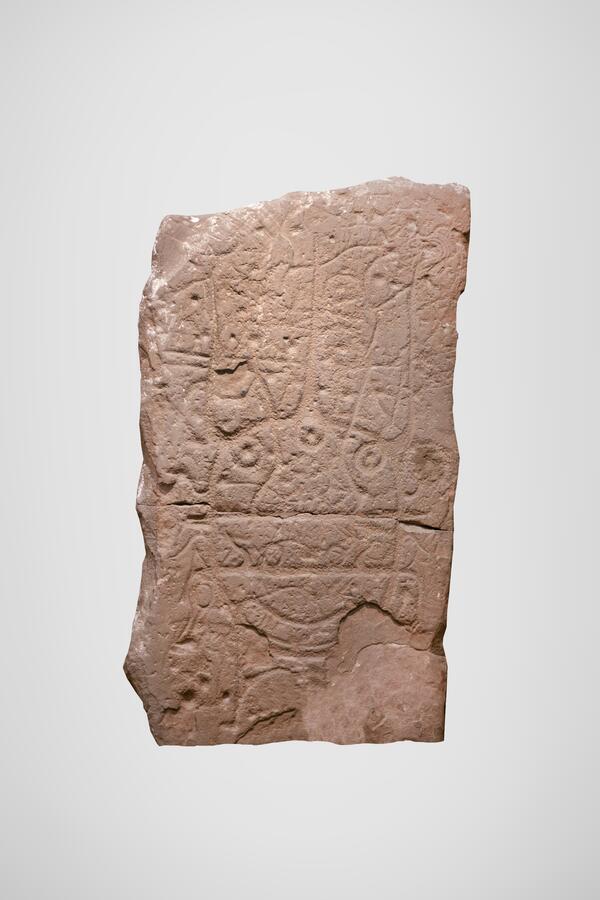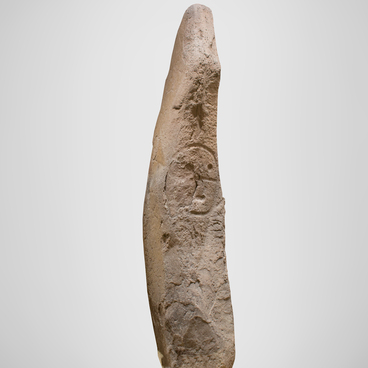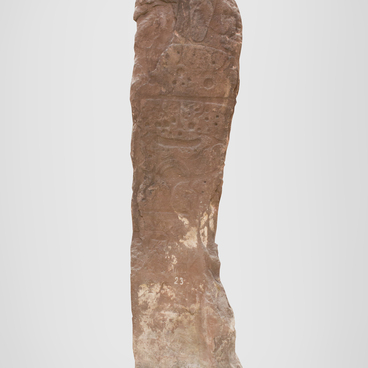The slab stela depicting a fantastic face was found near the central farm of the Esinsky state farm in the Askizsky district in Khakassia. It was part of the fence of the Tagar kurgan –— a monument of the archaeological culture of the early Iron Age. This culture dates back to 8–3 centuries BC, and the name was named after Tagarsky Island on the Yenisey River.
Tagar burial mounds can be found throughout the Khakass-Minusinsk depression. In the early stages, the Tagar people buried the dead in small mounds with square fences, at the corners of which they erected four sandstone stelae. Gradually, the fences became bigger and bigger, intermediate stones were added to them. Later monumental mounds were surrounded by fences of massive stone blocks up to two meters high. Often they took ancient slabs with drawings engraved on them. In the process of such reuse, new ones were often applied over the old sacred drawings.
The 1.5 meter stela found in the fence of the mound belongs to the Okunev archaeological culture; it was created in the period from the late 3rd — early 2nd millennium BC. On one of the wide planes, the ancient master pecked and then polished a large image of a fantastic face — an unrealistic creature similar in detail to a person.
The entire inner space of the face is divided by two horizontal lines into three parts, or three figurative belts. In the upper part of the mask, the master depicted the three eyes of a fantastic creature in the form of three circles with dots inside. The eyes are separated from each other by two curved vertical lines.
In the central figurative belt, the master depicted the nostrils of the deity in the form of two circles, which are connected by a curved horizontal line. The nostrils are adjacent to the lower dividing line. Short branching processes are depicted next to the circles. In the lower inner part of the mask, the master engraved the mouth of a fantastic creature in the form of a narrow and long, slightly curved oval.
In the upper part of the stela, above the image of the mask, many drawings and lines are visible, which are difficult to read and interpret. They were applied to the surface of the slab at a later time.
Tagar burial mounds can be found throughout the Khakass-Minusinsk depression. In the early stages, the Tagar people buried the dead in small mounds with square fences, at the corners of which they erected four sandstone stelae. Gradually, the fences became bigger and bigger, intermediate stones were added to them. Later monumental mounds were surrounded by fences of massive stone blocks up to two meters high. Often they took ancient slabs with drawings engraved on them. In the process of such reuse, new ones were often applied over the old sacred drawings.
The 1.5 meter stela found in the fence of the mound belongs to the Okunev archaeological culture; it was created in the period from the late 3rd — early 2nd millennium BC. On one of the wide planes, the ancient master pecked and then polished a large image of a fantastic face — an unrealistic creature similar in detail to a person.
The entire inner space of the face is divided by two horizontal lines into three parts, or three figurative belts. In the upper part of the mask, the master depicted the three eyes of a fantastic creature in the form of three circles with dots inside. The eyes are separated from each other by two curved vertical lines.
In the central figurative belt, the master depicted the nostrils of the deity in the form of two circles, which are connected by a curved horizontal line. The nostrils are adjacent to the lower dividing line. Short branching processes are depicted next to the circles. In the lower inner part of the mask, the master engraved the mouth of a fantastic creature in the form of a narrow and long, slightly curved oval.
In the upper part of the stela, above the image of the mask, many drawings and lines are visible, which are difficult to read and interpret. They were applied to the surface of the slab at a later time.



